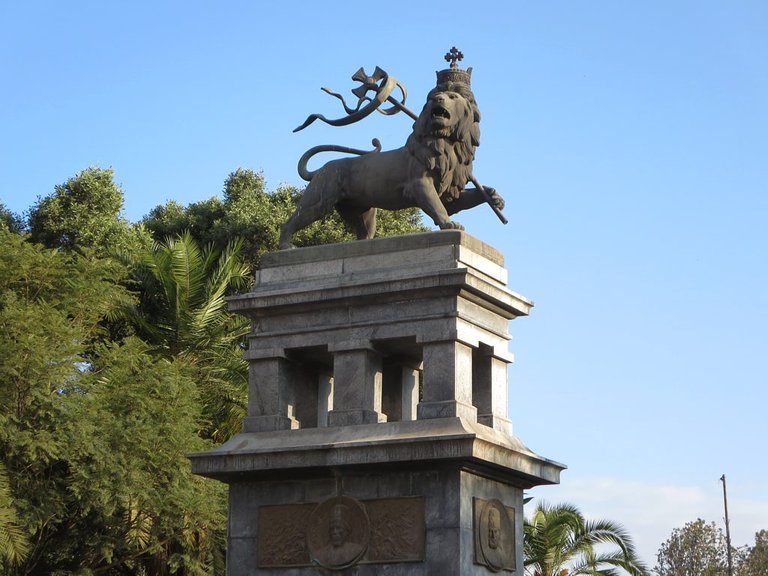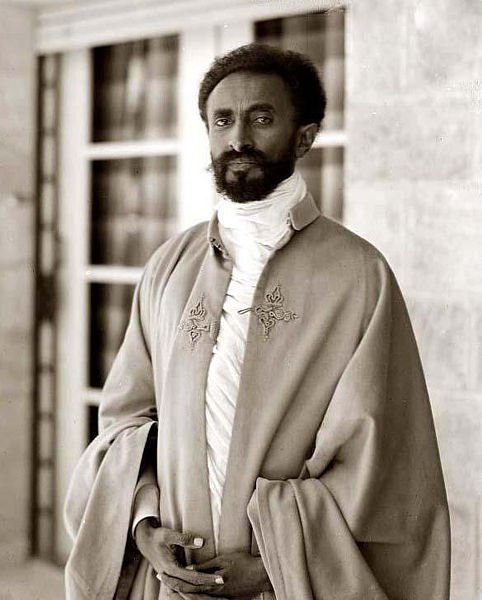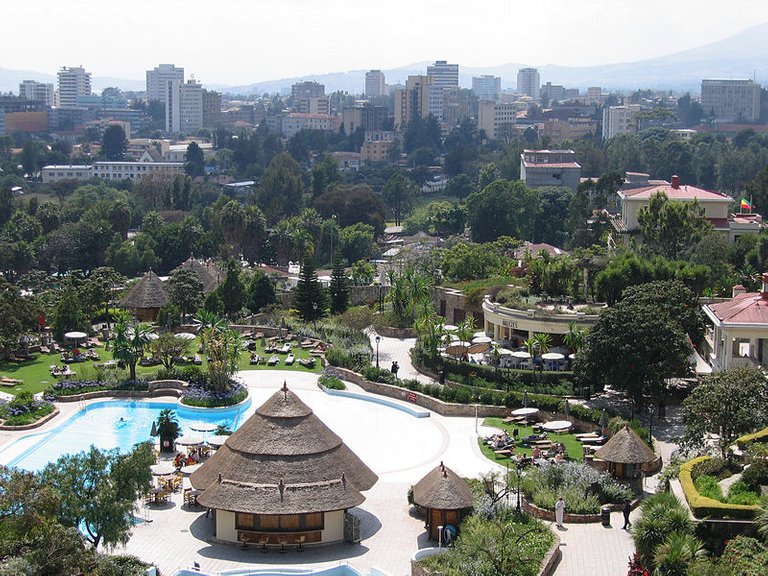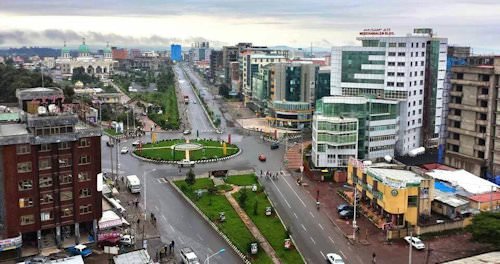
The Lion of judah lagahr
Addis Ababa is the capital city of Ethiopia and the African Union and is often called the "African Capital" due to its historical, diplomatic and political significance for the continent. Located in the foothills of the Entoto Mountains and standing 7,726 feet (2,355 meters) above sea level, it is the third highest capital in the world. It is located in the geographic center of the country. Addis Ababa which mean “new flower” is the world's largest city that is in a landlocked country. Addis Ababa is an important administrative center not only for Ethiopia but also for the whole of Africa. The headquarters of the African Union and the United Nations Economic Commission for Africa can both be found in the city. The United States and the European Union both have two delegations in Addis Ababa, one for bilateral relations with Ethiopia and one for the African Union. Ethiopia and its capital city have become a source of pride for the Pan-African movement due to its indigenous character and the legacy of the Abyssinian Empire.
Geography
This city's name is sometimes spelled "Addis Abeba," which means "new flower" in the Amharic language. Empress Taitu named the city, which is also known by the Oromo language name “Finfinnee.” Other parts of the city were called hora Finfinnee, meaning "hot springs."
The city is located at the southern foot of Mount Entoto, in the Entoto Mountains, at an elevation of about 8000 feet (2440 meters) above sea level, on a plateau that is crossed by numerous streams and surrounded by hills and mountains, in the geographic center of the country. Mount Yarer overlooks the city from the east and Mount Wochecha from the west.
The Entoto Mountains are home to numerous churches, a museum of religious costume, and a park. Ecologically, Addis Ababa is a grassland biome, which is a climatically and geographically defined area of similar communities of plants, animals, and soil organisms.
The city possesses a complex mix of highland climate zones, with temperature differences of up to 10°C (50° F), depending on elevation and prevailing wind patterns. The high elevation moderates temperatures year-round, and the city's position near the equator means that temperatures are very constant from month to month. The temperature in January ranges from a high of 68°F (20°C) to a low of 53°F (12°C).
The area of the city increased from 85.73 square miles (222.04 square kilometers) in 1984 to 204.7 square miles (530.21 square kilometers) in 1994.
The Entoto Mountains start among the northern suburbs. Suburbs include Shiro Meda and Entoto in the north, Urael and Bole (home to Bole International Airport) in the east, Nifas Silk in the south-east, Mekanisa in the south, and Keraniyo and Kolfe in the west.
The rapid population growth has created slums. Some areas have 200 people per acre, living in ramshackle attached houses built without regard to sanitation or drainage. About 60 percent of residents use dung as fuel, and 35 percent use firewood and leaves. About 37 percent use a combination of electricity and firewood.
History
Unlike many other African capitals, the founding, growth and development of Addis Ababa are not rooted in colonization. The modern city was founded in 1886, by Emperor Menelik II, at the site of a hot spring chosen by Empress Taytu Betul. Menelik, initially a King of the Shewa province, had found Mount Entoto a useful base for military operations in the south of his realm. Entoto, situated on a high tableland, was found to be unsatisfactory because of extreme cold and a shortage of firewood.
Initially, Taytu built a house for herself near the "Filwoha" hot mineral springs, where she and members of the Showan Royal Court liked to take mineral baths. Other nobility and their staffs and households settled the vicinity, and Menelik expanded his wife's house to become the Imperial Palace, which remained the seat of government in Addis Ababa. The name changed to Addis Ababa and became Ethiopia's capital when Menelik II became Emperor of Ethiopia in 1889. The city grew around the emperor's palace, which was surrounded by the dwellings of his troops and retainers.
The city was in danger of being abandoned in the early 1900s due to a shortage of firewood. The solution was an ambitious campaign to plant Eucalyptus trees, imported from Australia, in and around the city as a fuel wood and construction material. Today, a greenbelt of forests and semi-subsistence cultivated land surrounds the city. The completion in 1917 of the railway to Djibouti accelerated the city's somewhat haphazard and unplanned growth.
On May 5, 1936, Italian troops occupied Addis Ababa during the Second Italo-Abyssinian War, making it the capital of Italian East Africa from 1936 to 1941. Modern stone houses were built, many roads were paved, a water reservoir was built at Gefarsa in the west, and a hydroelectric station at Akaki to the south.

Emperor Haile Selassie.
After the British army and the Ethiopian patriots defeated the Italian army during the East African Campaign in Ethiopia Haile Selassie, who was Emperor from 1930, returned to Addis Ababa on May 5, 1941, and immediately began the work of re-establishing his capital.
Growth occurred in three waves after the Second World War, with the largest population boom during the late 1960s, as rural to urban migration reached its peak. Between 1960 and 1970 the population of the city nearly doubled, and new light manufacturing industries were established. Emperor Haile Selassie helped form the Organization of African Unity in 1963, and invited the new organization to keep its headquarters in the city.
Inflation and a lack of jobs for college graduates led to student protests. In 1974, students, laborers, and military officers staged a coup and established a socialist military government
Drought and famine that struck the country in the mid-1980s meant that hundreds of thousands fled economic misery, conscription, and political repression and went to live in neighboring—countries and all over the Western world—creating an Ethiopian diaspora.
When Eritrea, a former province of Ethiopia, gained independence in 1991, thousands of peasants and villagers fled, settling in large numbers in Addis Ababa. Many of the sick and maimed flocked there, along with a huge number of children who had lost parents to the war. These destitute migrants formed the lowest class of beggars and street vendors. In 1991, over 100,000 street children lived in Ethiopian cities, mostly in the capital.
The OAU was dissolved in 2002 and replaced by the African Union, also headquartered in Addis Ababa. The United Nations Economic Commission for Africa also has its headquarters in Addis Ababa. The city was also the site of the Council of the Oriental Orthodox Churches in 1965.
Government
Addis Ababa is one of two self-governing administrations in the nine ethnically based states that make up the Federal Democratic Republic of Ethiopia. The nation is unique among African countries, in that the ancient Ethiopian monarchy maintained its freedom from colonial rule with the exception of the 1936-41 Italian occupation during World War II. Ethiopia is the oldest independent country in Africa and one of the oldest in the world—at least 2,000 years.
Addis Ababa has the status of both a city and a state, with a charter endorsed by the national government. The Mayor has responsibilities that include: primary, secondary, and college education; primary health care, health centers, and hospitals; policing, water supply and infrastructure. The city council, which is elected directly every five years, provides the mayor with a cabinet, which functions to help the mayor in decision-making.
Arkebe Oqubay was mayor from early 2003 to May of 2005, when he lost to Berhanu Nega. But Nega's CUD, or Kinijit party, were imprisoned for two years on charges of attempting to overthrow the government. The government appointed a provisional city government with Berhanu Deresa the acting mayor.
It is a relatively clean and safe city, with the most common crimes being pocket-picking, scams and minor burglary.

View from the Sheraton Hotel in Addis Ababa
Economy
The economic activities in Addis Ababa are diverse. In 2007, some 119,197 people in the city were engaged in trade and commerce; 113,977 in manufacturing and industry; 80,391 homemakers of different variety; 71,186 in civil administration; 50,538 in transport and communication; 42,514 in education, health and social services; 32,685 in hotel and catering services; and 16,602 in agriculture, according to Ethiopian official statistics.
The main industrial area is in Akaki, in the south-eastern part of the city, where the largest factories are located. Most industries are government-owned, although increasing numbers are privately owned. Manufacturing includes footwear, clothing, asbestos and metal products, processed foods, cement, and plywood.
In addition to the residents of rural sections of Addis Ababa, the city dwellers also participate in animal husbandry and cultivation of gardens. In the early twenty-first century, 677 hectares (1673 acres) of land is irrigated annually, on which 129,880 quintals of vegetables are cultivated.
Many poor Ethiopians from the rural areas come to Addis Ababa as beggars and fill some of the streets, although the number of beggars declined after a government attempt to move some of them and provide education and jobs.
A vast open-air market known as the Mercato, on the western side of the city, is the site for trade of leather, metal, and textile goods from flourishing craft industries, and regional agricultural produce, such as coffee, tobacco, and dairy foods. It is the largest open market in Africa.
The city has undergone a construction boom with tall buildings rising in many places. Also, various luxury services have become available and the construction of shopping malls has recently increased. Some people have labeled the city, "the spa capital of Africa.
Addis Ababa is the hub of a road network, and the terminus of a rail link to the Gulf of Aden port of Djibouti City, with a picturesque French style railway station. Buses or blue and white share taxis provide public transport.
The city is served by Bole International Airport, where a new terminal opened in 2003. The old Lideta Airport in the western "Old Airport" district is used mostly by small craft and military planes and helicopters.

Demographics
Addis Ababa had a population in 2008 of 3,147,000, consisting of 1,511,000 men and 1,636,000 women, and an eight percent annual growth rate. The city is home to 23.8 percent of all urban dwellers in Ethiopia, and has an estimated density of 5936.2 per square kilometer. It is the 106th largest urban area in the world, according to Demographia.
Almost all the Ethiopian ethnic groups are represented in Addis Ababa due to its position as capital of the country. The major ethnic groups represented are the Amhara (48.3 percent), Oromo (19.2 percent), Gurage (17.5 percent), and Tigray (7.6 percent), while others constitute 7.4 percent of the population.
About 82 percent of the population are Orthodox Christians, 12.7 percent Muslims, 3.9 percent Protestants, 0.8 percent Catholics, while the remaining 0.6 percent are followers of other religions, such as Hindus, Jews, Bahá'ís, and Agnostics.
Addis Ababa University was founded in 1950 and was originally named "University College of Addis Ababa," then renamed in 1962 for the former Ethiopian emperor Haile Selassie I who had donated his Genete Leul Palace to be the University main campus in the previous year. It received its current name in 1975. Although the university has six of its seven campuses within Addis Ababa (the seventh is located in Debre Zeit, about 45km), it also maintains branches in many cities throughout the country. It is the home of the Institute of Ethiopian Studies and the Ethnological Museum.
Language
Ethiopia has many indigenous languages (84 according to the Ethnologue, 77 according to the 1994 census), most of them Afro Asiatic (Semitic, Cushitic, Omotic), plus some that are Nilo-Saharan. English is the most widely spoken foreign language and is the medium of instruction in secondary schools and universities. Amharic was the language of primary school instruction, but has been replaced in many areas by local languages such as Oromifa and Tigrinya. After the fall of the Derg regime in 1991, the new constitution of the Federal Demeocratic Republic of Ethiopia granted all ethnic groups the right to develop their languages and to establish mother tongue primary education systems. This is a marked change to the language policies of previous governments in Ethiopia.
Society and Culture
The People
Ethiopia is a multi-cultural and multi-ethnic country. Religion is a major influence in Ethiopian life. Nearly half the population belongs to the Ethiopian Orthodox Church but there is a also large Muslim population. Others adhere to an ancient form of Judaism.
The Ethiopian Orthodox Church is proud of its origins. The country embraced Christianity in the 4th century, long before Europe. The feast of the Epiphany ("Timkat") is the largest festival of the year. The Orthodox Church dominates the political, cultural, and social life of the population. It was the official religion of the imperial court and of the establishment until Haile Selassie was deposed in 1974.
Muslims are important in the business community. They tend to live in the eastern, southern, and western lowlands, although there are considerable numbers in Addis Ababa.
Family
The extended family remains the focus of the social system. It includes relatives on both sides of the family as well as close friends. Quite often the husband’s parents will live with the nuclear family when they get older and can no longer care for themselves. When people marry, they join their families, thus ensuring that there will always be a group to turn to in times of need. Individuals achieve recognition or social standing through their extended family. A family's honor is influenced by the actions of its members. Family needs are put before all other obligations, including business.
Customs
Meetings
Ethiopian greetings are courteous and somewhat formal.
The most common form of greeting is a handshake with direct eye contact.
The handshake is generally much lighter than in Western cultures.
After a close personal relationship has been established people of the same sex may kiss three times on the cheeks.
Across genders, men should wait to see if a woman extends her hand.
Greetings should never be rushed. Take time to inquire about the person’s family, health, job, etc.
People are addressed with their honorific title and their first name. “Ato", "Woizero", and "Woizrity" are used to address a man, married woman, and unmarried woman respectively.
Elders should be greeted first.
It is customary to bow when introduced to someone who is obviously older or has a more senior position. Children will often be seen doing so.
Gift Giving
Gifts may be given to celebrate events of significance or religious occasions.
Since Ethiopia is an extremely poor country, expensive gifts are not the norm.
In fact, giving a gift that is too expensive may be viewed negatively. It may be seen as an attempt to garner influence or it may embarrass the recipient as they will not be able to match it in kind.
If you are invited to an Ethiopian’s home, bring pastries, fruit, or flowers to the host.
A small gift for the children is always appreciated.
Do not bring alcohol unless you know that your host drinks. Most Muslims and Amharic people do not.
Gifts are not opened when received.
Gifts are given with two hands or the right hand only; never the left hand.
Culture
Ethiopians are hospitable and like to entertain friends in their homes.
An invitation to a private home should be considered an honour.
Punctuality is not strictly adhered to although considerable lateness is also unacceptable.
You may have to remove your shoes at the door.
Shake hands with each guest individually.
A woman should offer to help the hostess with the preparation or clearing up after a meal is served.
You will always be offered a cup of coffee. It is considered impolite to refuse.
Ethiopians are relatively formal and believe table manners are a sign of respect.
Do not presume that because food is eaten with the hands, there is a lack of decorum.
Expect a small earthenware or metal jug to be brought to the table before the meal is served. Extend your hands over the basin while water is poured over them.
Only use the right hand for eating.
Hierarchy dictates that the eldest person is the first to take food from the communal plate.
Guests are often served tasty morsels by another guest in a process called "gursa". Using his hands, the person places the morsel in the other person’s mouth. Since this is done out of respect, it is a good idea to smile and accept the offering.
Expect to be urged to take more food. Providing an abundance of food is a sign of hospitality.
The meal ends with ritual hand-washing and coffee.
Coffee Drinking
The Kaffa province in Ethiopia is renowned for its coffee.
Coffee is a national drink and its drinking is a ritualized process that generally takes at least an hour.
If invited for a formal coffee you may be seated on pillows or grass and flower-strewn floor with frankincense burning in the background.
A woman or young boy enters the room to wash and roast the beans over charcoal.
The roasted beans are then hand-ground and added to boiling water.
Sugar is put into small cups without handles and the water/coffee mixture is added.
Inhale the aroma of the coffee before sipping.
The first round (called "awol") is served, starting with the eldest.
When the first cup is finished, the "jebena" (coffee pot) is refilled with water.
The second round (called "tona") is then served. It is weaker than the first since the same ground beans are used.
The third round (called "baraka") is served after boiling water is again added to the jebena.
Always sip the coffee slowly.
Business Custom and Protocol
Greetings are formal and courteous.
Handshakes are somewhat prolonged and not especially firm.
They are always combined with strong, direct eye contact.
There is generally no touching between the sexes; however, if a foreign businesswoman extends her hand, a cosmopolitan Ethiopian may accept it to avoid causing her offense.
Never rush greeting; inquire about people’s families, health and work.Government officials may be addressed as "Excellency" without using their name.Wait to be invited before moving to a first name basis without the honorific title.
Business cards are given without formal ritual.
Present and receive business cards with the right hand only or with both hands.
Communication Style
Ethiopians can be very sensitive when it comes to communication. Since they have only recently begun working with foreigners in business situations they are still getting used to new ways of doing business and communicating.
As a general rule, they are humble and respect that quality in others. They generally speak in soft tones. Loud voices are seen as too aggressive. Ethiopians pride themselves on their eloquent speaking style and expect others to speak clearly and use metaphor, allusion, and witty innuendos. They often use exaggerated phrases to emphasize a point.
As a rule, Ethiopians tend to be non-confrontational and offer what they believe is the expected response rather than say something that might embarrass another. Honour and dignity are crucial to Ethiopians and they will go out of their way to keep from doing something that could bring shame to another person. Therefore, it is important to treat your
Ethiopian business colleagues with utmost professionalism and never do anything that would make them lose dignity and respect.
Business Meetings
Meeting schedules are not very rigid in Ethiopia. There may be an agenda, although it is not part of the local culture. If one is used, it functions as a guideline for the discussion and acts as a springboard to other related business topics.
Since relationships are extremely important, meetings start with extended social pleasantries. You will be offered tea or coffee and will be expected to ask questions about the other person and respond to questions about yourself.
Meetings seldom have a scheduled ending time since it is considered more important to complete the meeting satisfactorily than be slavishly tied to the clock. The meeting will end when everyone has had their say and the most senior Ethiopians decide that there is nothing left to be discussed.
Performing favours indicates friendship. Therefore, Ethiopians feel obliged to do something if asked by a friend. Since they generally only conduct business with people they consider friends, they have difficulty saying "no" to requests from business associates. This does not indicate that they will do what they have agreed to do, however.
Source
Bahru Zewde, A History of Modern Ethiopia 1855-1991
https://www.commisceo-global.com
http://www.newworldencyclopedia.org
Hi! I am a robot. I just upvoted you! I found similar content that readers might be interested in:
http://web.newworldencyclopedia.org/entry/Addis_Ababa
Congratulations @gmsan! You have completed some achievement on Steemit and have been rewarded with new badge(s) :
Click on any badge to view your own Board of Honor on SteemitBoard.
For more information about SteemitBoard, click here
If you no longer want to receive notifications, reply to this comment with the word
STOP